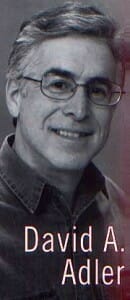 It is not every day that I have the opportunity to interview someone who has devoted decades to writing 200+ books. Wow! That is an amazing accomplishment. David Adler’s contribution to children’s literature covers numerous genres- mysteries, biographies, historical fiction, math, Jewish holidays, and the Holocaust. His audience includes people who read picture books, early level chapter books, mid level chapters as well as non-fiction books.
It is not every day that I have the opportunity to interview someone who has devoted decades to writing 200+ books. Wow! That is an amazing accomplishment. David Adler’s contribution to children’s literature covers numerous genres- mysteries, biographies, historical fiction, math, Jewish holidays, and the Holocaust. His audience includes people who read picture books, early level chapter books, mid level chapters as well as non-fiction books.
Like many other writers I have interviewed on this site, David was a teacher before starting to publish children’s books. While studying for a PhD in marketing in the 1970s, he switched career paths and started to write.
I first was exposed to David’s books, when my eldest son, Josh, was reading chapter books in the 1980s. The Cam Jansen series introduced Josh to mysteries. After I became a teacher, I read more and more of David’s books. I have previously shared some of his stories on this website .
I recently reached out to David. He graciously sent several books in exchange for an honest interview and review. David is participating in a book giveaway. Remember to leave a comment on this blog so that you will be eligible.
Welcome David.
Thank you.
In the 1970s, few fathers opted to take a child care leave. You were indeed a rarity. Did you know others who made this choice? How did that special experience help you write the Cam Jansen series? As a young male writer, how were you able to effectively create the voice of a young inquisitive girl?
Sandy, at the time I didn’t know anyone else who was a stay-at-home dad. There also were few people I knew who approved of my choice. At the time we lived in an apartment in Queens, NY and each afternoon when Michael awoke from his nap I took him in his carriage for a walk. Then I sat on a bench in the nearby playground and park. I was surrounded with mothers and their babies and they all moved away from me. If I had any doubt how people felt it was removed when a stranger, a woman, walked past me and called out, “You should be at work. Your wife should be at home with your child.” What shocked me is this stranger knew nothing of my situation. She just “knew” it was wrong for a father to take care of his child.
If anyone is interested, take a look at the very first Cam Jansen Mystery, Cam Jansen and the Mystery of the Stolen Diamonds. It’s the story that launched the series. The story and the solution to the mystery is based on child care, that when you take an infant out of the house you can’t just take the baby. You need to take along all sorts of “baby stuff,” a bottle, pacifier, extra diapers, baby wipes, and creams. How did I know all that? I did it every day.
It’s interesting that you asked how I could write about Cam, a girl. Well, the first manuscript was about a boy, not a girl, with a photographic memory. When Viking Penguin decided to make the story the first in a series my editor asked (insisted) I change the main character’s gender to differentiate my series from another they were just beginning to publish, Seymour Simon’s Einstein Anderson science based mysteries. While Jennifer Jansen, Cam’s real name, is a girl, in many ways she’s a stereotyped boy. I am still surprised no feminist group has heralded the series breaking across stereotypes. I guess it all works and seems so natural is that no one has taken note of it.
After decades of writing children’s literature, what steps do you take to remain up-to-date on the current trends of today’s youth? Are there any significant differences between the first Cam Jansen books and the latest ones?
I try to keep up to date by attending conferences, reading writing journals, and speaking to my editors.
I don’t think the Cam writing has really changed since the series began. In the early 1980s when I proposed a more introspective story, my editor told me that type of writing was for another character, not Cam. She insisted I keep the writing style consistent.
Many young readers shy away from nonfiction and prefer fiction. Nevertheless, you have written numerous biographies for an elementary school audience. Do you choose the subjects or does your publisher decide on the personalities? On average, how long does it take to research these biographies? What tools do you use to help reluctant readers become engaged with the stories of notable individuals?
It seems easier to me for a beginning writer to begin with nonfiction. The subject helps sell the manuscript. With all my nonfiction, both I and my editors need to want to do the book. For biographies, either I begin with a proposal and an editor wants to do the book or an editor suggests the subject to me.
Authors oftentimes use family members, acquaintances and work relationships as templates for their stories. Are any of your book characters based on people that you know?
I think they all are.
Many parents and educators question whether elementary school children should be exposed to the Holocaust. You have authored several Holocaust books that address this audience. At what age should parents and teachers share Holocaust picture books? Do you have an underlying objective when you write Holocaust books?
I believe children should be introduced to difficult subjects in cycles. My book The Number On My Grandfather’s Arm is appropriate for a third-grader. My book We Remember The Holocaust is right for a sixth grader. A child, even a sixth grader and beyond who has never been exposed to any Holocaust literature will be shocked. We cannot shield our children forever from horrible truth. We as parents and educators must instead prepare them and age appropriate literature does that.
In One Yellow Daffodil: A Hanukkah Story, you successfully create a Holocaust story that captures a common survivor response. What do you hope your young readers will learn from this story?
I still get teary-eyed when I read that story. I see it as a real tikkun-olam** story. Surely one of the messages is that we all have to reach out and embrace others.
**Tikkun Olam- (Hebrew phrase defined as repairing the world.) In modern times this term refers to social action and the desire to pursue social justice.
In Don’t Talk to Me About the War, middle level readers are taken on a journey back to New York in the 1940s. They are introduced to many events leading up to America’s involvement in World War II, notable events in American baseball, and the debilitating effects of Multiple Sclerosis (MS). This story is considerably more complex than the easier chapter books. Since you were born after the end of World War II, what steps did you take to research the historical aspects of this story? Did you have to do additional research to understand the health ramifications of MS?
For every day of the story I had a copy of that day’s newspaper on my desk. All the news is accurate, even the baseball scores, weather, and radio broadcasts. I listened to some of the radio programs Tommy in the story listened to. I lived that story! For the MS part of the story I interviewed an eighty year old woman whose mother had MS diagnosed in early 1940. I spoke with a neurologist. I obtained a 1940 medical text. I had to know not only about the disease but how it was diagnosed and treated in 1940. I already knew a bit about MS from the experiences in my family with the disease.
In 2013, you authored and illustrated a new series- Danny’s Doodles: The Jelly Bean Experiment. Later this year, the second book, Danny’s Doodles: The Squirting Donuts will be published. Why did you choose to illustrate this series? The main character, Danny Cohen, is Jewish. Can you talk about the Jewish values that you will be including in this series? How many additional books do you anticipate publishing?
I really enjoy writing about Danny and his friend Calvin Waffle. Just this week I completed the third book in the series Danny’s Doodles: The Dog Biscuit Breakfast and gave the manuscript to my eight year-old grandson to read. He laughed aloud many times as he read it. Each story has a Jewish value at its core. Danny’s Doodles: The Jelly Bean Experiment is about welcoming the stranger and there are few people stranger that Calvin Waffle — and few more interesting. Danny’s Doodles: The Squirting Donuts is about returning something that’s lost. That book is due to be published in September. Doodles: The Dog Biscuit Breakfast is about visiting the sick. It’s due in 2015.
I love doing the doodles for Danny’s Doodles. Many years ago I illustrated magazines. I even sold a few cartoons, so illustrating Danny is not completely a new experience.
In addition to the Danny’s Doodles series, are you working on any other books?
I have another new series beginning in 2015, the Mo Jackson Sports Books. The books will be published by Viking Penguin, my Cam Jansen publisher. I am also working on nonfiction titles including Wheels, Levers, and Pulleys, an economics book Prices! Prices! Prices! and a math book. For Hanukkah 2015 I’ll have a book on tikun-olam, Hanukkah Cookies With Sprinkles. I’m beginning work on another older level biography for the same aged reader as my Colonel Theodore Roosevelt which is coming out this fall.
How does your early experience as an inner city teacher affect your school visits? Can you describe your most memorable school visit?
Teaching math in a tough school prepared me well for the many large audiences I speak to. I’m comfortable in front of groups of 200 – 300 children.
I’ve had many visits that were memorable for me. I couldn’t single out just one.
David, is there anything else that you would like to share with my audience?
I love to write. I guess it shows.
Book Awards:
- The Babe and I- California Medal
- Lou Gehrig: The Luckiest Man- The Boston Globe Horn Book honor
- The Number on My Grandfather’s Arm- the Sidney Taylor Award
- America’s Champion Swimmer Gertrude Ederle- NCTE Orbus Pictus Honor
- The Babe and I- Golden Kite Honor
- Holocaust books- Association of Orthodox Jewish Teachers award
- The Knickerbocker Award- lifetime achievement
Book Giveaway
Anyone who leaves a comment on this blog by Sunday, August 24 will be eligible for a book giveaway. David Adler will send the randomly selected winner an autographed copy of Danny’s Doodle.
Related Blogs:
Four New Picture Books for Passover
Q & A with Ruth Tenzer Feldman
Multicultural Picture Book- Benjamin of Tudela
Time Traveling Back to the Dreyfus Affair
Sandra’s Bio
Sandra Bornstein is the author of MAY THIS BE THE BEST YEAR OF YOUR LIFE. It is available on Amazon. Sandra’s memoir highlights her living and teaching adventure in Bangalore, India. She is a licensed Colorado teacher who has taught K-12 students in the United States and abroad as well as college level courses. Sandra is married and has four adult sons. The memoir was a finalist in the Travel category for the 2013 Next Generation Indie Book Awards, the 2013 International Book Awards, the 2013 National Indie Book Excellence Awards, the 2013 USA Best Book Awards, and received an Honorable Mention award in the Multicultural Non-Fiction category for the 2013 Global ebook Awards.
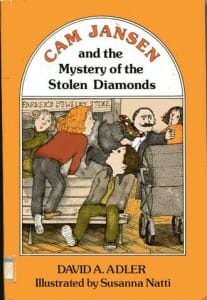
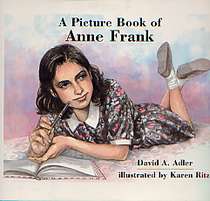
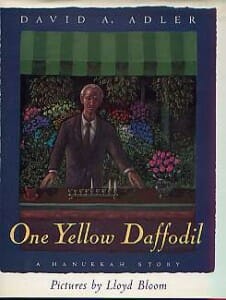
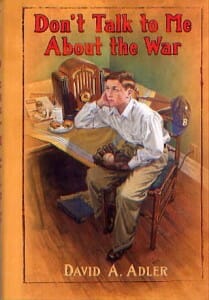
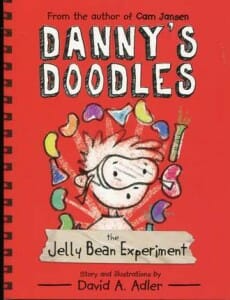
What an excellent interview! I grew up reading Cam Jansen books and loved hearing a little background about the character and how David’s background shaped the first Cam Jansen Mystery. What a wealth of children’s books he’s created! The Danny’s Doodles books sound great and I’m so glad to hear that a new series will be out in 2015 as well.